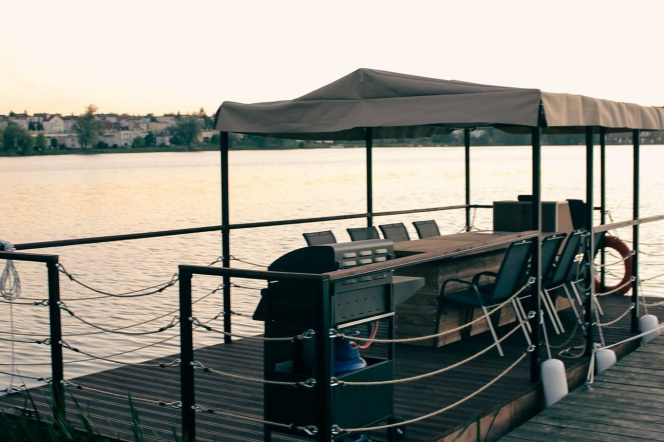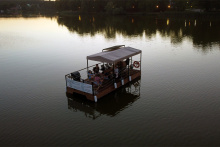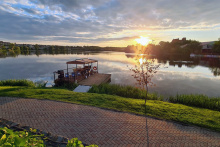Date added: 2021-08-05
Students created a floating platform on which you can ... have a barbecue

Students of Gdańsk University of Technology (two from the Faculty of Mechanical Engineering and Ship Technology, two from the Faculty of Civil and Environmental Engineering), the Warsaw School of Economics and the Sopot University of Applied Sciences took part in the project.
- The home port of the floating unit is Iława in the Warmian-Masurian Voivodeship, located on the longest lake in Poland, i.e. Jeziorak - said Wojciech Podwalski, a student of mechanics and machine construction at the Faculty of Mechanical Engineering and Ship Technology at Gdańsk Tech. - It is from its name that the whole project, as well as the platform itself took their name in the documents - "YEAHziorak" - he added.
The unit is powered by a 10 HP Honda outboard engine connected to the gear and steering wheel via steering lines, which allows for trouble-free control, even by an inexperienced person. The speed developed by the unit is about 8 km / h, which, combined with the overall dimensions and engine power, allows, in accordance with Polish law, to control it without a patent.
- We started by designing a frame with floats - said Wojciech Podwalski. - We decided on a simple and proven solution, used in the construction of floating platforms, i.e. the use of food barrels. They have about a centimeter thick wall made of plastic, thanks to which they are deformable and resistant to mechanical impact, and provide adequate buoyancy - he added.
The deck of the platform measures 7 m × 2.8 m, and the roof frame at the lowest point is almost 2 m high. There is also a 2.5 m x 2.8 m space with a gas grill and three sun loungers. In addition, on the platform you can also have a table, eight chairs, a refrigerator with a capacity of over 40 liters, a cigarette lighter socket and 6 USB ports for charging electronic devices, as well as remote-controlled LED lighting.
When it comes to safety, there are 12 life jackets for adults and four for children, a powder extinguisher, a first aid kit, a lifebuoy with a safety cord, and the main power and gas switches.
Like a catamaran?
The structure floats on the water thanks to the use of 16 barrels with a capacity of 200 liters, which gives 3200 kg of displacement. They are arranged in rows - on both sides - seven on each side, similar to catamaran floats. Two additional pieces are placed in the aft section which is most heavily loaded. The tare weight of the platform with its full equipment is one ton, and its maximum draft is 0.4 m.
The platform frame was designed by students in two parts - steel (load-bearing) and wooden, which is attached to the steel one for deck assembly.
For the construction of the steel frame, the students purchased over 350 kg of S235JRH steel. It is a single, coherent, welded closed element to prevent water from entering it. Water may be a source of corrosion or additional ballast. The frame also has welded "skis", i.e. elements protecting the floats from the bottom, front and rear, which allows to better hold them in place and protects them against possible damage in the event of the platform running aground. A base for an adjustable transom to the engine has been welded on the stern. The frame is fully protected with two layers of anti-corrosion primer and two layers of paint, so there was no need to galvanize it.
The wooden frame was placed on a similar steel structure. It was made of natural wood and screwed with special screws. It is fully protected with a special hydrophobic preparation.
- We attached corrugated pine boards ordered from a sawmill to the wooden frame at appropriate intervals. The use of the same several millimeter gaps between them makes it easier to clean the deck, causes it to dry faster, prevents passengers from slipping, even when it is wet, and at the same time makes it difficult for a telephone, for example, to slip into the water. The deck boards are also protected with a hydrophobic preparation - explained the student.
Ecological solution
The entire electrical installation is powered by a 450 W photovoltaic panel, placed on a special rack above the stern part of the canopy. In addition, a battery with a capacity of 100 Ah has been installed to start the engine and as an energy storage, which is charged directly from the photovoltaic panel. Apart from that, the platform has the so-called "Port plug", thanks to which it is possible to charge the battery with alternating current from the socket, e.g. when the platform is staying in a marina. In the event of a power failure, the engine can be started using the so-called starter.
At the beginning of June 2021 the platform underwent a technical inspection, after which it was registered as a motor yacht for commercial purposes.
Work on the project lasted about 3.5 months. It was entirely financed by students.
Six students took part in the project:
- Bartosz Burzyński, Gdańsk University of Technology, Faculty of Mechanical Engineering and Ship Technology, Mechatronics
- Wojciech Podwalski, Gdańsk University of Technology, Faculty of Mechanical Engineering and Ship Technology, Mechanics and Machine Design
- Karol Kowalski, Gdańsk University of Technology, Faculty of Civil and Environmental Engineering, Construction
- Piotr Jastrzębski, Gdańsk University of Technology, Faculty of Civil and Environmental Engineering, Geodesy and Cartography
- Paulina Krzeczkowska, Warsaw School of Economics, Management
- Maciej Bajer, Sopot University of Applied Sciences, Faculty of Architecture, Architecture and Town Planning.
Photo 1
YEAHziorak platform created by students
Photo 2
Students’ platform floating on Jeziorak



